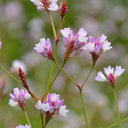[Expression and clinical significance of Dyrk1b in the specimens and cells of cervical lesions].
Mots clés
Abstrait
OBJECTIVE
To detect and explore the expression and clinical significance of dual specificity tyrosine phosphorylation regulated kinase1b (Dyrk1b) in the specimens and cells of cervical lesions.
METHODS
(1) All the data were collected from 75 patients with cervical cancer and 52 cases with squamous intraepithelial lesion (SIL) admitted in the First Affiliated Hospital of Dalian Medical College during Jan. 2011 to Dec. 2013 and confirmed by pathological examination, included 60 cases of stage Ⅰ and 15 cases of stage Ⅱ, 12 cases with low-grade squamous intraepithelial lesion (LSIL) and 40 cases with high-grade squamous intraepithelial lesion (HSIL). While, 28 cases with chronic cervicitis were chosen as the control group. The protein expression of Dyrk1b was detected by immunohistochemistry among the four groups. (2) The expression of Dyrk1b in HeLa and SiHa cells were detected by western blot method and the expression of Dyrk1b protein were also detected after treatment of AZ191 (5, 10 μmol/L) for 48 hours in HeLa and SiHa cells. (3) The cellular survival and proliferation of HeLa and SiHa cells treated by different concentrations of AZ191 (2.5, 5, 10, 25, 50, 100 μmol/L) for 48 hours were detected by methyl thiazolyl tetrazolium (MTT) assay. (4) The rate of apoptosis of HeLa and SiHa cells was detected by flowcytometry after treatment of AZ191 (5, 10 μmol/L) for 48 hours.
RESULTS
(1) The positive rates of Dyrk1b protein in chronic cervicitis, LSIL, HSIL and cervical squamous cancer by immunohistochemistry were 11%(3/28), 1/12, 42% (17/40) and 71% (53/75), respectively. The expression of Dyrk1b in cervical squamous cancer and HISL were higher than those in LSIL and chronic cervicitis (P<0.01), there were significant difference between cervical squamous cancer and HSIL, or between HSIL and LSIL (all P<0.05), while there were not significant difference between LSIL and chronic cervicitis (P>0.05). Expression of Dyrk1b was correlated with stromal invasion depth of cervical cancer (P<0.05), but not with age, clinical stage, lymph node metastasis, and serum squamous cell carcinom antigen (SCC-Ag) levels (all P>0.05). (2) Dyrk1b protein was expressed in different levels in HeLa and SiHa cells, and the expression of Dyrk1b was decreased gradually as the increased of the concentration of AZ191 in both HeLa and SiHa cells by treatment of AZ191 for 48 hours. (3) Different concentration of AZ191 treated on cervical cancer cells could inhibit the cellular proliferation and induce cell apoptosis in a concentration-dependent manner (P<0.01), concomitant to the decreased cell survival rate. The apoptosis rate of HeLa and SiHa were increased significantly after 10 μmol/L AZ191-treatment for 48 hours, but no any difference induced by 5 μmol/L AZ191-treatment compared to control group. Also,there was no any difference between Hela and SiHa cells in either inhibitory effect or apoptosis rate induced by AZ191.
CONCLUSIONS
Dyrk1b is over-expressed in either specimens or cells of cervical cancer. The expression of Dyrk1b protein in cervical lesions is increased as the progression of disease. Dyrk1b inhibitor AZ191 could inhibit cellular proliferation and induce apoptosis in a concentration-dependent manner in cervical cancer cells.


